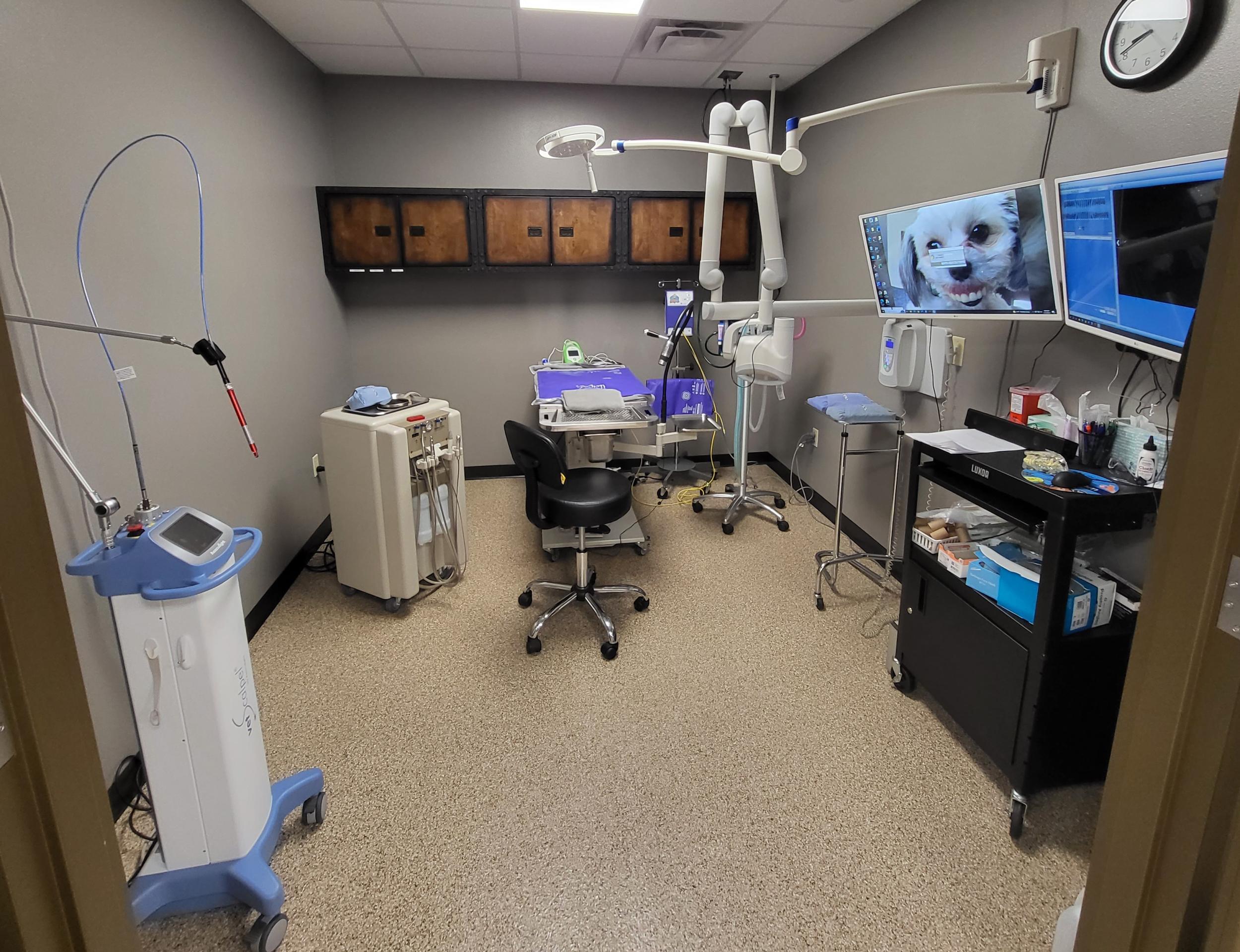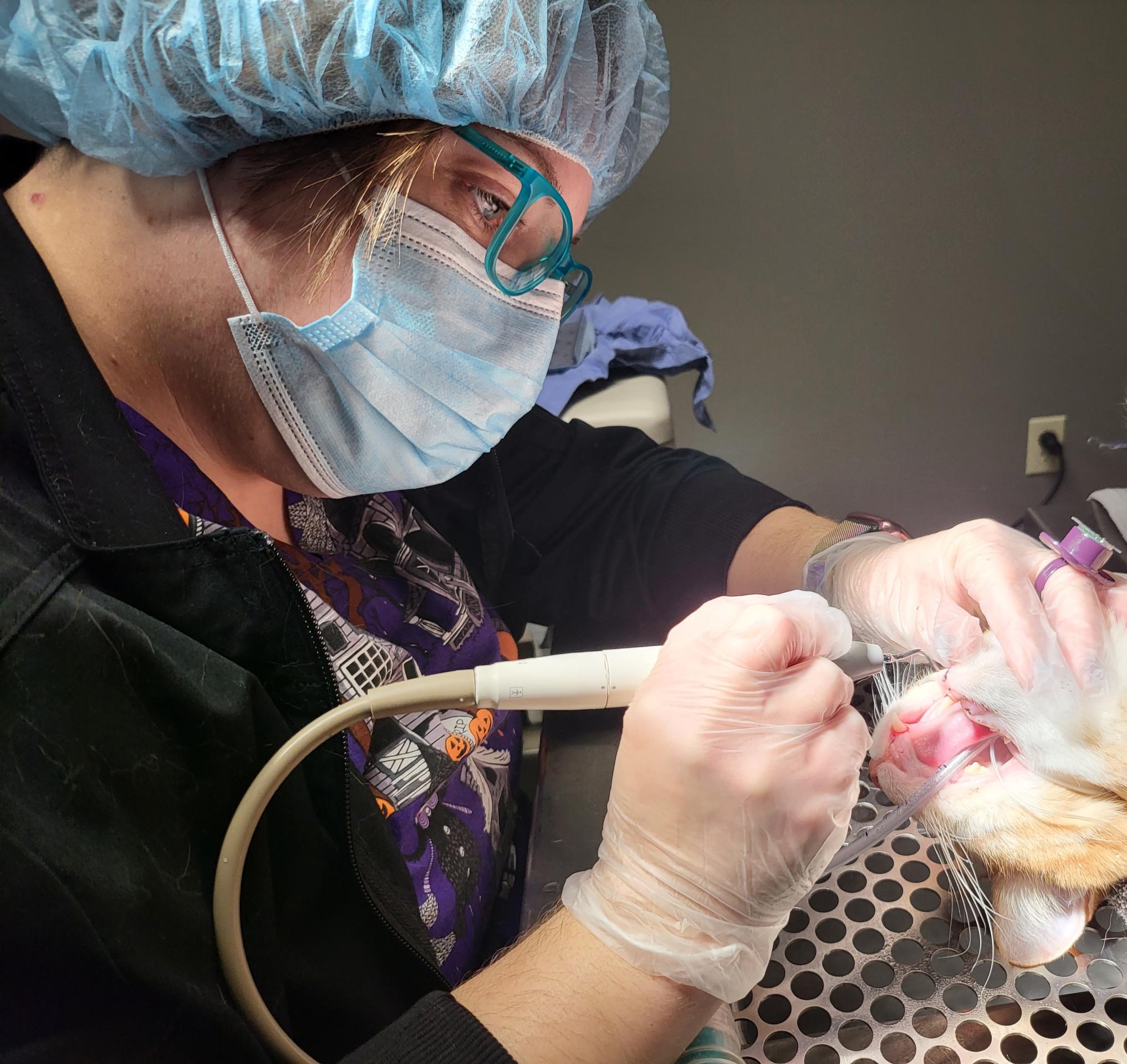Prioritizing Your Pet's Oral Health for a Happier, Healthier Life
Oral health plays a vital role in your pet's overall well-being, and modern veterinary dentistry goes far beyond "just a dental cleaning." At The Hometown Veterinarian, our Comprehensive Oral Health Assessment and Treatment (COHAT) ensures your pet receives thorough care to detect and address oral health issues before they cause pain or affect whole-body health.
Why Dental Care Matters for Pets
Much like in human dentistry, early detection and treatment of oral health issues are essential for preventing pain and ensuring long-term health. Neglecting dental care can lead to painful conditions like infections, tooth loss, and even systemic illnesses caused by bacteria entering the bloodstream. That's why we prioritize advanced techniques, state-of-the-art equipment, and compassionate care to deliver the high standard of dentistry your pet deserves.
The Standard of Care in Veterinary Dentistry
At The Hometown Veterinarian, we focus on far more than surface-level cleaning. Every procedure includes a comprehensive evaluation of your pet's mouth, complete with digital radiographs (X-rays) to uncover hidden issues like bone loss or abscesses below the gumline. Hasty "scraping" techniques that skip this deeper evaluation are outdated and can leave your pet in pain with untreated disease.
Our veterinary hospital is equipped with the tools and expertise to provide dental care that meets and exceeds industry standards. From pre-anesthetic safety protocols to post-operative pain management, every step of the process is designed with your pet’s safety and comfort in mind.
What Are the Key Factors to Consider in the Standard of Care for Pet Dentistry?
1. Dental Screening Exams
During regular checkups, we perform an awake visual examination of your pet’s teeth and gums to look for early signs of problems. We also review their prior dental and medical history, as this can provide critical insights into potential underlying issues.
2. Pre-Anesthesia Lab Work
Ensuring your pet is a good candidate for anesthesia is a top priority. Before any dental procedure, we conduct a comprehensive blood profile to evaluate organ health and perform a thorough physical exam. For certain pets, additional diagnostics like chest X-rays, urinalysis, or advanced blood tests may be necessary to assess their overall health more completely.
3. General Anesthesia
To provide a thorough dental cleaning and examination, general anesthesia is essential. "Non-anesthetic cleanings" are purely cosmetic and fail to address disease beneath the gumline. Moreover, procedures like probing, scaling, and taking dental X-rays cannot be performed on an awake pet without causing significant pain or distress.
At The Hometown Veterinarian, we use advanced anesthetic protocols, monitoring, and preoperative planning to make anesthesia as safe as possible for your pet.
For more information on anesthesia, see our dog anesthesia and cat anesthesia pages.
4. Comprehensive Oral Exam Under Anesthesia
Once your pet is under anesthesia, we conduct a detailed assessment of their entire oral cavity. This includes evaluating the gums, teeth, and surrounding structures for ulcers, inflammation, masses, fractures, discoloration, and other abnormalities.
5. Dental Radiographs (X-Rays)
Dental X-rays are a critical component of any professional veterinary dental procedure, as they allow us to diagnose issues hidden beneath the gumline, such as root abscesses, bone loss, or impacted teeth. Studies show that more than half of dental disease in cats and dogs can go undetected without X-rays, making them essential for a thorough and effective assessment.
Performing dental procedures without the use of X-rays risks leaving painful and potentially harmful conditions untreated, which is widely seen by modern veterinary professionals as malpractice. Skipping this vital diagnostic step can compromise your pet’s health and well-being. At The Hometown Veterinarian, dental X-rays are part of every dental procedure because we are committed to uncovering and treating all sources of oral pain and disease.
By including X-rays in our dental care, we can confidently identify and address conditions that may otherwise remain hidden, ensuring your pet leaves with a healthier, pain-free mouth.
6. Professional Dental Cleaning
Our thorough cleaning process removes plaque and tartar from both above and below the gumline, where disease often begins. After scaling, we polish each tooth to smooth the surface and help prevent future plaque buildup.

Treatment of Dental Disease: Addressing Pain and Infection
At The Hometown Veterinarian, our priority is to eliminate pain and infection in your pet’s mouth. Dental disease can significantly impact your pet’s quality of life, and timely treatment is essential to prevent further complications. Depending on the diagnosis, treatments may include:
- Tooth Extractions: Removing severely damaged or diseased teeth to alleviate pain and prevent infection from spreading.
- Endodontic Therapy (Root Canals): Preserving vital teeth by treating infections inside the tooth structure, ideal for specific cases.
- Restorative Procedures: Repairing damaged teeth to restore function and prevent future problems.
- Biopsies: Collecting tissue samples for further evaluation if oral masses or abnormalities are detected.
Each treatment plan is tailored to your pet’s unique needs, ensuring their comfort and well-being throughout the process.
Patient Monitoring and Pain Management
Patient Monitoring
Anesthetic safety is a top priority during all dental procedures. While your pet is under anesthesia, a skilled veterinary surgical assistant closely monitors vital signs such as heart rate, respiratory rate, blood pressure, and oxygen levels using advanced electronic equipment. This constant attention ensures your pet remains safe and stable throughout the procedure. Monitoring continues during recovery to provide a smooth and comfortable transition back to wakefulness.
Pain Management
Proactive pain management is an integral part of our dental care approach. From preoperative medication to reduce stress and discomfort to postoperative care for a smooth recovery, we ensure your pet remains as comfortable as possible. Our tailored pain management plans include:
- Anesthetic blocks during procedures.
- Anti-inflammatory medications to reduce swelling.
- Ongoing pain relief options to promote healing and comfort at home.
At The Hometown Veterinarian, we believe that minimizing pain is essential to your pet’s well-being, and we take every measure to ensure a stress-free experience.
Record-Keeping and Follow-Up Care
Detailed Record-Keeping
We maintain thorough digital records of every tooth from every dental procedure performed at The Hometown Veterinarian. This includes detailed notes on the findings of the oral exam, diagnostic imaging such as dental X-rays, and any treatments provided. These records are invaluable for monitoring your pet’s oral health over time and planning future care.
Post-Procedure Dismissal
Before your pet goes home, we review all findings, treatments, and X-ray results with you to ensure you have a complete understanding of the procedure. Our team provides clear instructions for at-home care, including medications, feeding guidelines, and tips for maintaining your pet’s oral hygiene.
Follow-Up Support
To ensure your pet’s recovery is progressing smoothly, we’ll follow up the next day with a phone call to check in. If additional care or follow-up appointments are needed, we’ll schedule those at your convenience to ensure your pet’s ongoing health and comfort.
Preventive Care: Maintaining Your Pet’s Oral Health
Proper home care is key to keeping your pet’s teeth and gums healthy between professional dental visits. At The Hometown Veterinarian, we offer guidance and tools to help you maintain your pet’s oral hygiene, including:
- Daily Teeth Brushing: Regular brushing is one of the most effective ways to prevent plaque and tartar buildup. Our team can demonstrate proper techniques and recommend pet-safe toothpaste.
- Dental Chews and Treats: Look for products approved by the Veterinary Oral Health Council (VOHC), which are proven to reduce plaque and tartar.
- Specialized Diets: Certain diets are formulated to promote oral health by minimizing plaque accumulation. We can recommend options tailored to your pet’s needs.
- Regular Wellness Exams: Routine checkups allow us to monitor your pet’s oral health and address issues early before they progress.
Why Choose The Hometown Veterinarian for Your Pet’s Dental Care?
At The Hometown Veterinarian, we are committed to delivering elite-level dental care with a hometown touch. Our comprehensive approach ensures that we address both visible and hidden dental issues, prioritizing your pet’s comfort, safety, and overall well-being.
What Sets Us Apart?
- We utilize advanced technology, including digital dental X-rays, for thorough diagnostics.
- Our team is skilled in the latest techniques for safe anesthesia, pain management, and oral surgery.
- We emphasize proactive prevention and personalized care to meet your pet’s unique needs.
Dental health is essential to your pet’s quality of life. By trusting The Hometown Veterinarian, you’re choosing a veterinary hospital that prioritizes the highest standard of care while treating every patient with compassion and expertise.
To learn more and to set up an evaluation, call our office at 641-758-3333 or click to Request an Appointment.
Do you have even more animal dentistry questions?
See our pages for:

